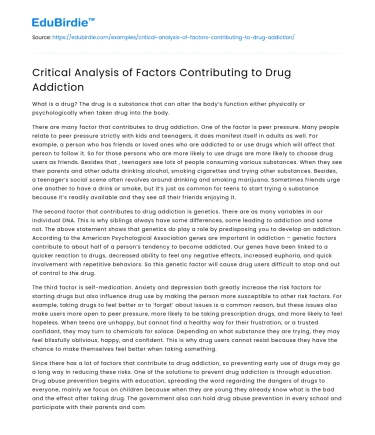Introduction
Drug addiction is a multifaceted issue that has garnered significant attention from both medical professionals and policymakers worldwide. The rise in addiction rates, alongside the devastating social and economic impacts, necessitates a comprehensive understanding of the contributing factors. This paper aims to critically analyze the various elements that lead to drug addiction, emphasizing biological, psychological, and social influences. By examining these determinants, we can better appreciate the complexity of addiction and explore more effective intervention strategies. Additionally, this analysis will consider counter-arguments to provide a balanced perspective, ultimately underscoring the need for a multifaceted approach in tackling this pervasive problem.
Biological Factors in Drug Addiction
Biological influences play a significant role in predisposing individuals to drug addiction. Research has consistently shown that genetic factors can account for up to 60% of a person's vulnerability to addiction (Volkow & Li, 2005). Specific genes are associated with an increased likelihood of engaging in addictive behaviors by affecting neurotransmitter pathways in the brain. For instance, the dopamine receptor gene DRD2 is frequently linked to addiction, as it affects the brain's reward system, making certain individuals more susceptible to the euphoric effects of drugs (NIDA, 2018).
Save your time!
We can take care of your essay
- Proper editing and formatting
- Free revision, title page, and bibliography
- Flexible prices and money-back guarantee
Moreover, neurobiological changes resulting from chronic drug use further exacerbate addiction. Prolonged exposure to substances can alter brain structure and function, particularly in regions related to motivation, memory, and behavior control (Koob & Volkow, 2010). These changes can persist long after drug use has ceased, contributing to the challenge of overcoming addiction. Opponents might argue that focusing on biological factors undermines personal agency. However, acknowledging the biological basis of addiction can enhance treatment approaches, such as personalized medicine, which tailors interventions to an individual's genetic makeup.
Transitioning to the psychological domain reveals another layer of complexity in addiction. While biology provides a foundation, psychological factors significantly influence the development of addictive behaviors.
Psychological Influences and Mental Health
Psychological factors, including mental health disorders, significantly contribute to the onset and progression of drug addiction. Individuals with co-occurring mental health conditions, such as depression, anxiety, or PTSD, often turn to substances as a form of self-medication (Khantzian, 1997). This reliance can lead to a cycle of dependency, as the temporary relief offered by drugs exacerbates the underlying psychological issues in the long term.
The concept of self-efficacy, or an individual's belief in their ability to succeed, also plays a critical role. Low self-efficacy can increase vulnerability to addiction by reducing one's perceived ability to cope with life's challenges without resorting to drugs (Bandura, 1986). Conversely, enhancing self-efficacy through targeted interventions has shown promise in addiction treatment programs.
Critics of the psychological perspective may argue that it places undue emphasis on internal factors while neglecting external influences. However, integrating psychological interventions with social and environmental strategies provides a more holistic approach to addressing addiction. The transition to social influences further demonstrates the interplay between individual and environmental factors in addiction.
Social and Environmental Contributions
Social and environmental factors are pivotal in shaping drug addiction patterns. Socioeconomic status, peer influence, and family dynamics are crucial determinants of drug use behavior. Individuals in lower socioeconomic brackets often face increased stress and limited access to resources, making them more prone to substance abuse as a coping mechanism (Galea & Vlahov, 2002). Additionally, peer pressure and the desire for social acceptance can lead individuals, particularly adolescents, to experiment with drugs (Hawkins et al., 1992).
Family environment also plays a crucial role in the development of addiction. Dysfunctional family relationships, characterized by neglect or abuse, can predispose individuals to seek solace in drugs. Conversely, strong family support can act as a protective factor, reducing the likelihood of substance abuse (Velleman & Templeton, 2007).
Those who emphasize personal responsibility might argue that social factors are merely excuses for individual choices. However, acknowledging the social context of addiction highlights the importance of community-based prevention strategies and policies aimed at reducing socio-economic disparities. In transitioning to the conclusion, it is evident that a comprehensive understanding of addiction requires integrating these biological, psychological, and social components.
Conclusion
In summary, drug addiction is a complex interplay of biological, psychological, and social factors, each contributing uniquely to the development and perpetuation of substance abuse. Acknowledging the genetic predispositions, psychological vulnerabilities, and social environments that influence addiction is crucial for devising effective prevention and treatment strategies. While counter-arguments emphasize personal responsibility, a multifaceted approach that considers all contributing factors provides a more comprehensive solution to this pervasive issue. By addressing the root causes of addiction through integrated interventions, society can better support individuals in overcoming addiction and reducing its widespread impact.






 Stuck on your essay?
Stuck on your essay?

